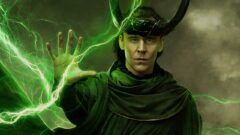For Avatar: The Way of Water, The Third Floor’s artists traveled back to Pandora and collaborated on environment and sequence building teams at Lightstorm Entertainment that would visualize content and prep camera loads for filmmaker virtual camera (VCAM). From New Zealand, The Third Floor’s Head of Virtual Production Casey Schatz served as Simulcam Supervisor, helping link the real and the virtual through innovations with techvis, eyelines, simulcam and motion control during the live-action shoot.
Previs was built based on concept art, script pages and guidance from Director James Cameron and VFX Supervisor Richard Baneham. The content took in assets from the art department and motion capture of characters to represent environments, lighting and action, and shots were developed and lensed by the filmmakers’ virtual camera, running Weta FX’s Gazebo engine. The Third Floor’s scene assembly group, with key leads Mark Nelson and Jason Brown, concentrated on sequences like the RDA landing, the Mag-Lev train attack and other story beats. Key artists also included Environment Supervisor Motoki Nishii and Technical Environment Lead Maria Ramos, who created environments, props and characters for virtual production and scouting.
Casey Schatz was a core crew member on set in New Zealand, working with camera operators, stunt coordinators, grips and visual effects personnel to inform filming day to day on the live-action stage. Collaborating with the director, Cinematographer Russell Carpenter and multiple departments, Schatz created on-set techvis using digital scans of physical sets to accurately simulate live-action filming setups ahead of time with the teams. Distances and speeds for cameras, positions for actors and the relationship of these to a wide range of specialty production equipment — from water tanks to vehicle rigs, could be assessed in real time, with the ability to see how new ideas and adjustments would affect the shot setup immediately.
Another focus for Schatz was making Cameron’s VCAM moves happen on set via the Technodolly. Schatz staged the director’s VCAM in a 3D LIDAR version of the actual shooting space, made speed and tempo translations for scale and ported the camera-ready move to the physical crane. Shots like the one of General Ardmore taking Colonel Quaritch on a construction tour of Bridgehead is an example of this VCAM-to-Technodolly workflow, used to capture plates for a believable walk-and-talk that matched what the director had done in VCAM, with Edie Falco’s Ardmore in the SkelSuit and Steven Lang as a digital Na’Vi.
Shots across the movie where live-action humans share scenes with digital characters used a new eyeline approach to enhance spatial awareness to the digital characters during live-action photography. The eyeline system played back facial capture reference on small HD monitors mounted to a small cable cam system and was designed by Lightstorm Entertainment’s Ryan Champney, with Schatz overseeing implementation and alignment on set. Ensuring the system replicated the Na’Vi character movement through space but did so safely was of utmost importance. This was accomplished by simulating the movement of the eyeline system and its cabling in Maya with LIDAR of the real set to verify there were no collisions.
Other areas of Schatz’s work included on-set simulcam and motion base programming, particularly for the Matador and Picador boats. These among the movie’s many other production and visual effects advancements worked hand in hand to help achieve a seamless marriage of live-action photography and digital imagery.








